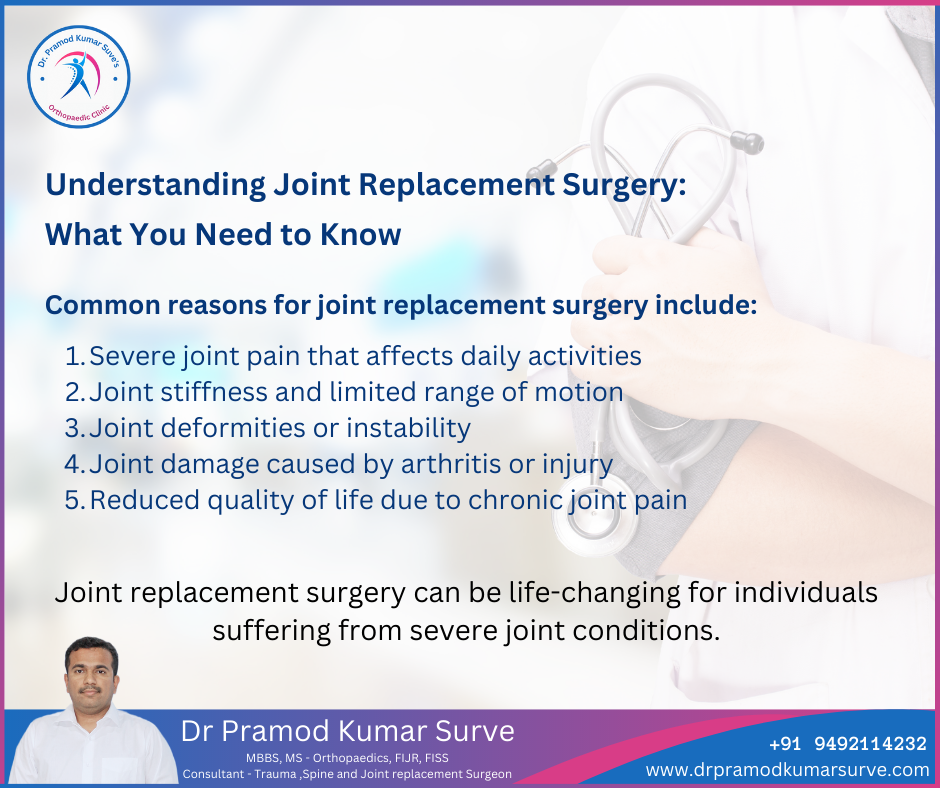Joint pain and stiffness can significantly affect one’s quality of life, making even simple daily activities a challenge. When conservative treatments fail to provide relief, joint replacement surgery becomes a viable option. In this article, we will explore the key aspects of joint replacement surgery and shed light on what you need to know about this procedure. We are fortunate to have Dr. Pramod Kumar Surve, an experienced orthopedic surgeon practicing in Hadapsar, who will share his insights on the subject.
About Dr. Pramod Kumar Surve:
Dr. Pramod Kumar Surve is a renowned orthopedic surgeon practicing in Hadapsar. With extensive experience in joint replacement surgery, he has helped numerous patients regain their mobility and improve their quality of life. Dr. Surve’s expertise, coupled with his compassionate approach to patient care, has earned him a stellar reputation in the medical community.
Understanding Joint Replacement Surgery:
Joint replacement surgery is a procedure in which a damaged joint is replaced with a prosthesis or an artificial joint. The surgery aims to relieve pain, improve joint function, and enhance mobility for individuals with severe joint conditions such as osteoarthritis, rheumatoid arthritis, or joint trauma. The most commonly replaced joints are the hips and knees, although joint replacement can also be performed on other joints like the shoulders, elbows, and ankles.
Reasons for Joint Replacement Surgery:
Joint replacement surgery is typically recommended when other treatment options, such as medications, physical therapy, and lifestyle modifications, have failed to alleviate the pain and improve joint function. Common reasons for joint replacement surgery include:
- Severe joint pain that affects daily activities
- Joint stiffness and limited range of motion
- Joint deformities or instability
- Joint damage caused by arthritis or injury
- Reduced quality of life due to chronic joint pain
The Joint Replacement Procedure:
Joint replacement surgery involves several steps, including:
- Preoperative evaluation: Your orthopedic surgeon will conduct a thorough examination and may order imaging tests, such as X-rays or MRI scans, to assess the joint’s condition.
- Anesthesia: Before the surgery, anesthesia will be administered to ensure a pain-free procedure. The type of anesthesia used may vary based on the joint being replaced and the patient’s overall health.
- Surgical procedure: The surgeon will make an incision to access the affected joint. The damaged joint surfaces will be carefully removed, and the artificial joint components will be placed securely. These components may be made of metal, plastic, or ceramic materials.
- Recovery and rehabilitation: Following the surgery, you will be closely monitored in the hospital to manage pain and ensure proper healing. Physical therapy will play a crucial role in helping you regain strength, flexibility, and joint function.
Benefits and Risks:
Joint replacement surgery offers several benefits, including pain relief, improved mobility, increased joint stability, and enhanced quality of life. However, like any surgical procedure, there are risks involved. Potential risks and complications may include infection, blood clots, nerve damage, prosthetic dislocation, or implant failure. It is essential to discuss these risks with your orthopedic surgeon beforehand.
Conclusion:
Joint replacement surgery can be life-changing for individuals suffering from severe joint conditions. With the guidance and expertise of professionals like Dr. Pramod Kumar Surve, patients can undergo the procedure with confidence, knowing they are in capable hands. If you are experiencing chronic joint pain and limited mobility, it is advisable to consult an orthopedic specialist to explore your treatment options and determine if joint replacement surgery is suitable for you. Remember, a pain-free and active lifestyle could be just a joint replacement away
